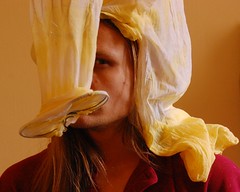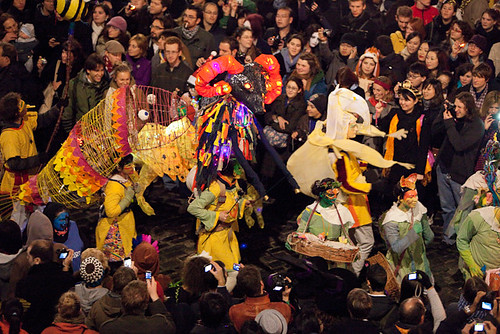Click here to read this mailing online.
|
The Ghost of Margaret ThatcherSome time around the middle of 2011 I had a vision of a puppet I could make, of the ghost of Margaret Thatcher. Although she was not yet physically dead, her spirit had been haunting the political landscape of Great Britain for some decades. You couldn’t see her, but sometimes this cold and oppressive presence would make itself felt, and you just knew that she was there – whispering in the corridors of Whitehall, stalking the nightmares of the children of the 80s.
It took me a while to work out how exactly I was going to do the hair, but once I hit on the idea of using Sainsbury’s bags, it seemed completely obvious. I advertised on FreeCycle, and found several people with surprisingly large collections of the things. I worked out that you can attach plastic bags to each other, or to many other things, by threading them through their own handles, so I just needed a crude frame to hold them all in place. For the body I took some polystyrene that a fridge had come wrapped in, and a baby-blue fleece blanket from a house I was cleaning out for some friends. With about six cuts, the blanket had lapels. My friend Farah – a fashion design student – came over and finished it off for me by sewing on sleeves and buttons, plus a rosette made out of blue fluff from the tumble dryer with a few scraps of the fleece. And googly eyes.
The actual weight-bearing structure of the puppet was almost the last thing I made, though I acquired the necessary rucksack-frame near the start of the process. I bolted a couple of hollow metal poles to the frame, and attached the folding wooden parts of an old laundry basket to them, and then I attached the large plastic spinal tube to that. The neck-pole rested inside the spinal tube, allowing the whole head to rotate 360 degrees. During the year or so that I was sporadically working on the puppet, I would occasionally tell people about the project, and they’d inevitably ask what it was for. I would tell them that I didn’t really have any particular occasion in mind, but I did know that in the event of her death, there would be a street party the following Saturday, and it would seem a shame to miss it. Around mid-March, I got to the stage where I knew I could finish it in a couple of days if the occasion arose, and on the Monday the 8th of April, Margaret Thatcher died in her bed at the Ritz. With help from the aforementioned friends I got the puppet finished up in good time, then I arranged some helpers for the day of the party. Five of us set out to get the bus into town, each carrying one or more components of the puppet. The driver of the first bus turned us away, but there was another 134 due in just a couple of minutes, and that one let us on. In the shelter beneath Centrepoint we met my brother and another friend, who had had the idea of making a coffin with the word ‘SOCIETY’ picked out in flowers. Together we assembled the various parts, and with the pack strapped to my back and someone operating each arm, we processed through the rain towards Trafalgar Square, coffin in tow, trying not to let Thatcher’s head smack into any street signs or theatre awnings on the way. We arrived at the party at about 6:30, to a round of applause from the thousands-strong crowd. As I explained to various journalists, I saw this as a chance to start laying Thatcher to rest, and for people to air their lasting anger and disgust with her legacy. I like to think that now she’s gone, we can focus on the fact that there really is such a thing as society, despite her best efforts to undermine it; greed turns out to have been dreadful all along; and there are alternatives to the money-addled neoliberalism that our unrepresentative democracy has stuck us with. There is a lot to fight for, but the world is changing fast, and I see reason to hope. As for my effigy of her ghost… I’m afraid it didn’t make it through the night, but here are some photos, here is some news coverage and here are some videos. Air PointUsually, at Edinburgh’s Beltane Fire Festival, the May Queen makes her way around the hill, visiting and ‘awakening’ performance groups representing the classical elements – Air, Earth, Water and Fire. In 2011, it happened that nobody put themselves forward to run a group for the element of Air. It is notoriously the hardest element to represent through the medium of dance and costume anyway, what with it being invisible. For Beltane 2009 I had been in an Air performance group myself, which was a lot of fun, but .
So I took a bunch of super-thick withies that I’d found dumped in the street one time, made a great big circle out of them, twisted around and held in place with wire and string. Then I took an enormously long strip of white cotton, about a centimetre wide,
The basic pattern is that shared by dreamcatchers everywhere, but to give it a spiral twist I made sure that each knot was over to one side, rather than in the middle between two knots of the outer ring. To allow it to pull down in the middle, I made sure the line was slacker and slacker as I approached the centre. Emmie contributed a normal-scale dreamcatcher to hang from it, and so did Sacha Harrison, one of the White Women assigned to the element of Air, with added decorations. I extended the spirals of the main net beyond its bottom with a sort of converging double-helix, and hung one of the dreamcatchers from the centre. My main role at that year’s festival was as one of the official photographers, so I had the opportunity to capture this image of the installation at the moment of the May Queen’s blessing. Unfortunately, while I was off speed-editing my pictures from the night, a pair of drunken punters stumbled into the sculpture and destroyed it. Still, my mother taught me at an early age about the concept of ‘art for the gods’, which is always destined to be destroyed, and it is hard to imagine a more apt example. Kenneth Mark IIDoes this control box for my wave-based interactive animations count as a sculpture? I’m thinking it just about does, even though it’s a far cry from the sort of thing I normally include here; either way, my main post about it is over on my generative art blog Third Giant Puppet: Hati the WolfThe Samhuinn Fire Festival in Edinburgh has more often than not featured a pack of wolves in one form or another – the Wild Hunt, hounding the spirits of Summer, is one of its recurring symbols, and for me has been one of the big highlights of the Samhuinns I have attended as an audience member. The Wolves in 2010 were largely metaphorical, more lupine humans than humanoid wolves, but they still tore the vitals from our fantastical-animals Summer Troupe. This year the wolves were less numerous, but wolfier – just two of us with giant puppets. When I started thinking about this year’s festival, I found myself with an unusually clear vision of the puppet-wolf I wanted to make. A lot of my art comes out of doodling to see what emerges, so when I do have a persistent creative vision, I tend to feel like I owe it to myself to make it happen. Pleasingly, this year’s Samhuinn was even more puppet-based than last year’s, with one large group of puppeteers where usually there are several separate performance groups. Here’s a gallery of puppetry photos from the night, and here are some photos of my puppet-making process. My wolf would be mounted on a backpack frame, like my previous puppets, but this time the head would be a couple of feet above and in front of my own head. I had a collection of much thicker bendy sticks than our usual withies – presumably also willow – that I found in the street one time, and these would be my main construction material. They’re strong, but they have a lot of give in them, so the puppet has a great deal of movement in it – freed from the traditional bamboo skeleton, it bounces around of its own accord and takes a moment to settle back down after any sudden movement. It has its own rhythm, so the operator needs to work with its impulses rather than trying to control every motion.
Once I had mounted the head on the sticks, I started thinking about how to make it as visible as it should be, and I hit on the idea of helping to hold and bring out the shape of the wolf with more of those cloth strips, using the same sort of crude knots I’d learned for my Air sculpture. After some thought, I concluded that I needed to cover the sides of it and the head with some cloth. I left the back open, a decision I would regret slightly in the torrential rain of Samhuinn night.
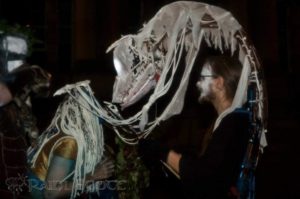 Hati meets the Cailleach. Photo by Raini Scott. The front legs are made from strips of the white cotton, plus a sheet of muslin for the upper part. They are attached to paws made of wire and bound in cotton, with claws made of Fimo Air Light and coated in PVA glue for shininess and waterproofing. The paws are attached to sticks of bamboo for control. Inspired by careful observation of Muppets in action, I made sure that I could control both arms with one hand, with the sticks crossed over, leaving my other hand free to operate the mouth and head. The fangs are made from the same air-drying clay as the claws, while the rest of the teeth are just torn-up tissue paper and PVA, formed around a little cone of plastic sheeting and then immediately removed. This technique allowed me to make as many teeth as I wanted very quickly. One of the bits that I left till last, in case I ran out of time, was the hind legs. These aren’t really part of the puppet; I just sewed tubes of muslin around each of the shoulder straps, hiding the incongruous blue plastic. Then I cut a series of slits at the bottom of the muslin, and using PVA I very quickly formed the ends of the cloth into little claw shapes. Here’s the finished puppet in action, indoors. And here are some clips from the night itself: clip 1, clip 2, clip 3.
Many thanks to everyone in the group – and to all the photographers who took great photos, and everyone else involved as performers, tech, stewards or audience members. I had one of the best nights. 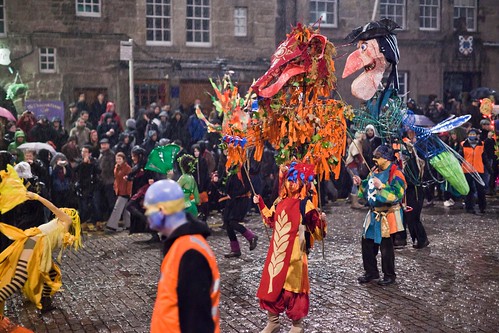 Summer puppets. This and previous photo by Chris Scott
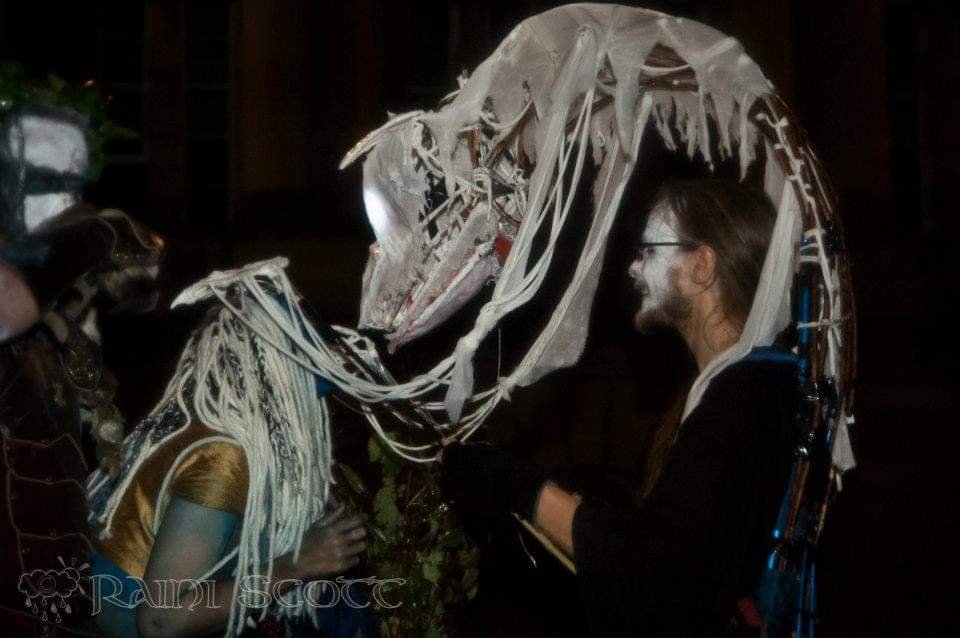 Second giant puppet: Tara the Tapir
According to Japanese myth, tapirs eat your dreams. After performing at Beltane with a huge, towering puppet, I decided I’d rather scale back a bit for Samhuinn. There is something to be said for being so tall that a crowd of hundreds can see you clearly, but it’s also true that as soon as you are a head and shoulders above any crowd you can start making an impact from a long way off.
The whole thing has muslin stretched over it to create an illusion of solidity. The hind legs are attached to the waistband of the backpack frame. The front legs are attached to the top of the frame, and come over my shoulders so that I can control them with a sort of bamboo handle.
I made a hinged and counter-weighted jaw so that when I tip my head back, the mouth gapes open and reveals Tara’s fearsome tapir teeth and lolling tongue. For the hinge, I just twisted the jaw-wire around another wire going horizontally across the head. The principle is pretty straightforward – the weight keeps the jaw roughly level, while the rest of the head rotates around it – but getting the weighting exactly right required a fair bit of trial and error.
To make the puppet more visible in the night, and to give the wolves of winter something to show off after they dismembered Tara, I made a glowing brain out of two LED push-lights and cotton wool, and tied it to the top of the head using flimsy wool. Tara was joined on her journey by an extremely varied group of puppets – Hannah‘s manticore Manny, Milk‘s snake, Koralia’s fish-beast, Alison’s fairy-lit ram and Ross‘s giant Beebeard, attended by spotters wielding sticks topped by a bird, a bee and a pig. Here’s a video of us all in action, and here’s a gallery of photos featuring Tara.
For this year’s Samhuinn – tomorrow night! – there are even more puppeteers. It’s going to be spectacular. My own puppet is a sort of a giant wolf-beast, on the Winter side of the battle this time. I’ll post all about it after I recover from the night itself… First photo is by Star Cat (slightly edited by me); the second is by Brian Gratwicke; the last one is by digiphotoniel. All others taken by the author. More Recent Articles |


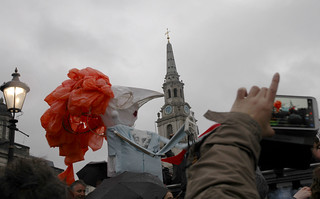


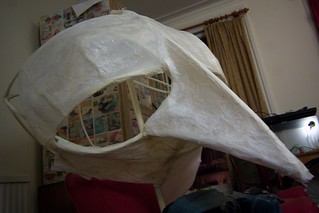



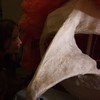
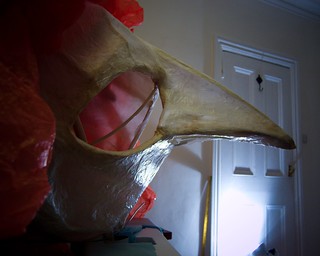
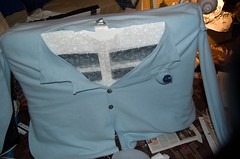
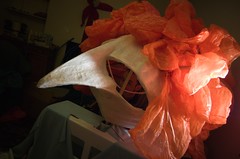
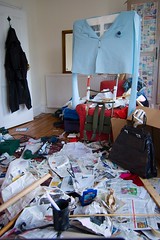

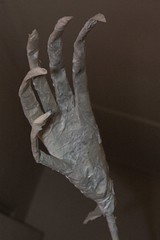

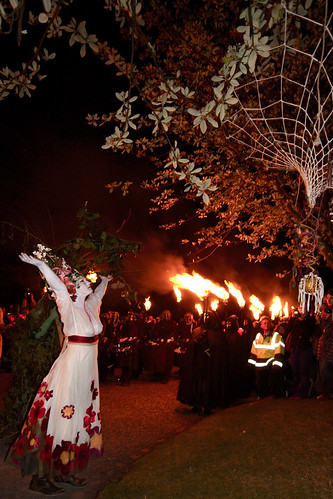

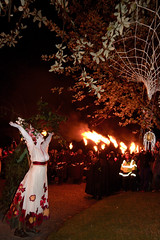

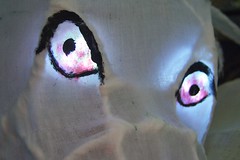
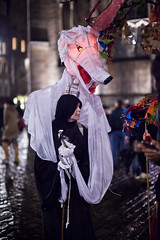

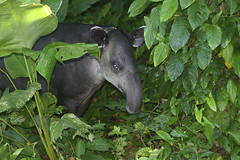
 My tapir, Tara, was roughly life-sized, and positioned like I was giving it a piggy-back. Tara’s body is built right onto a backpack frame, using withies (bendable willow-sticks) to give it its shape,
My tapir, Tara, was roughly life-sized, and positioned like I was giving it a piggy-back. Tara’s body is built right onto a backpack frame, using withies (bendable willow-sticks) to give it its shape, 

